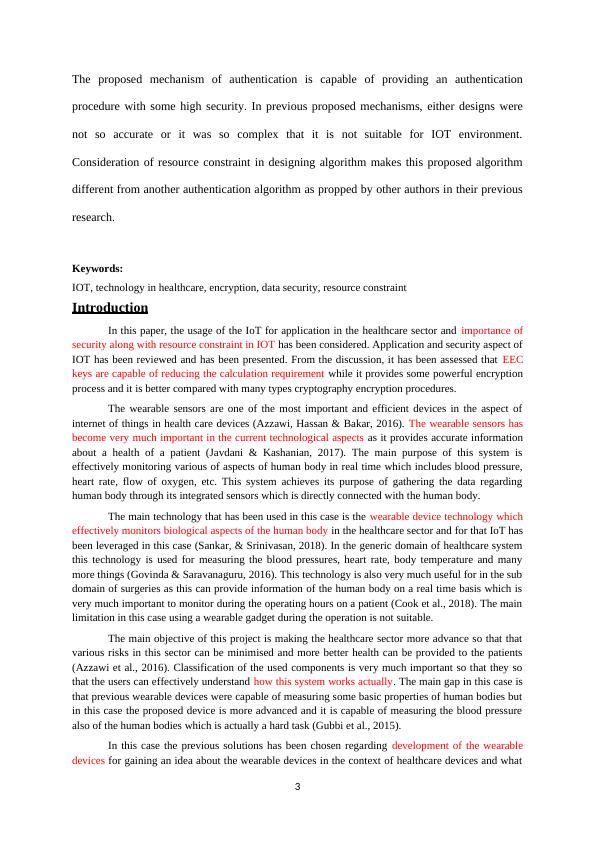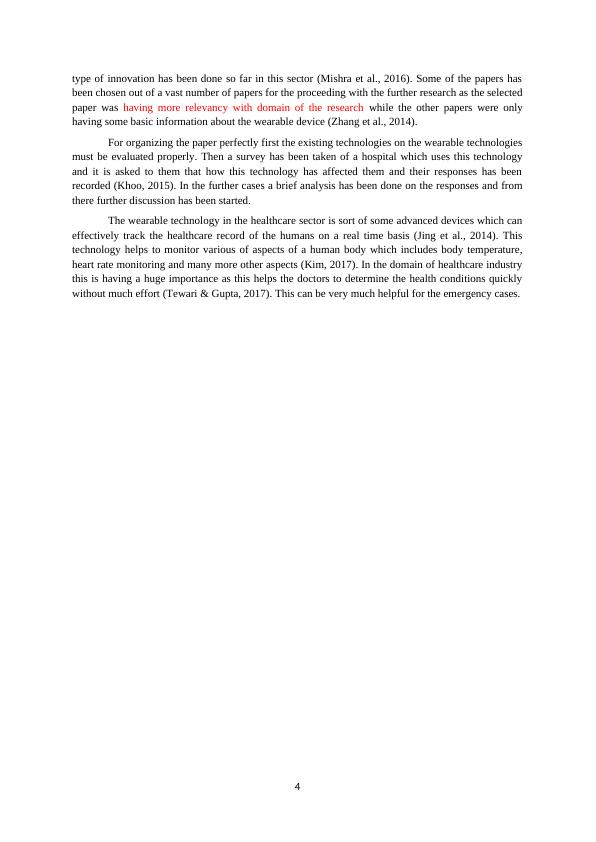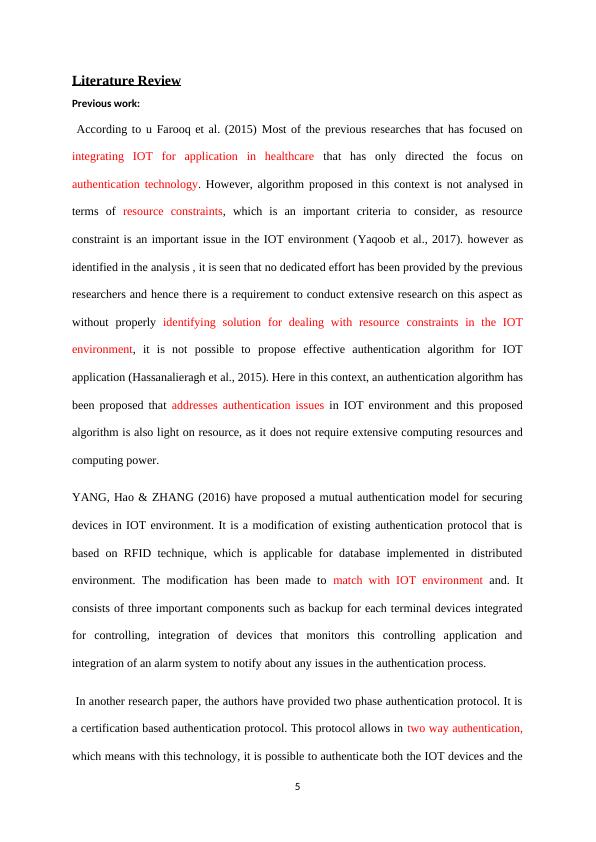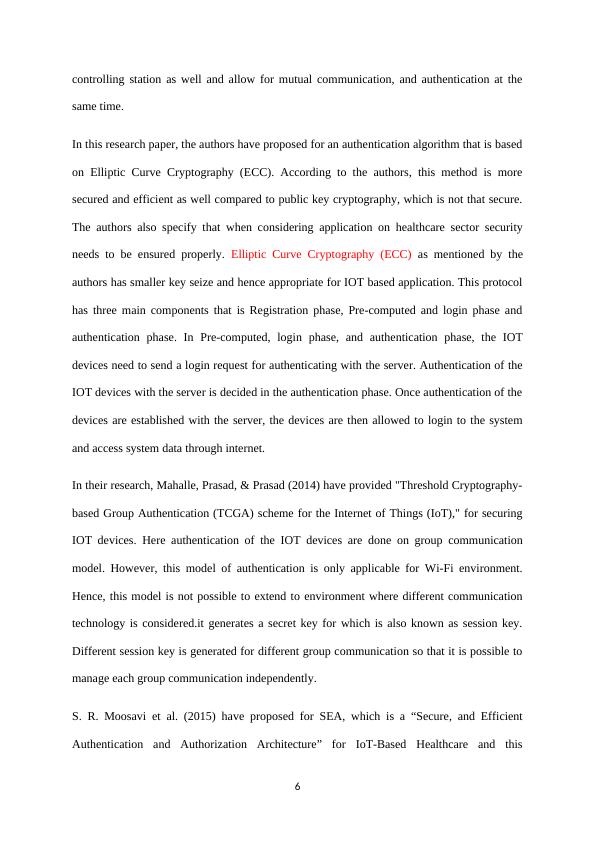IoT in Healthcare: Securing Data and Enhancing Authentication for Wearable Devices
Added on 2023-04-25
29 Pages9374 Words104 Views
Internet of Things for Smart Healthcare: Technologies, Challenges, and
Opportunities
1
Opportunities
1

Abstract
In the current context the Internet of Things has become a very important domain where the
sensors and the embedded systems are capable of connect to each other and are also capable
of exchanging data among them. The IoT devices has gained so much importance in the last
few decades as this has provided many advantages to most of the industries and sectors which
includes the healthcare sector also. The data of the IoT is very much critical so it must be
ensured that the data are always secured from external threats and hackers. Thus in this
aspects the security constrains are very much important to keep the data of IoT safe from the
hackers and the intruders. The nature of the IoT devices as a resource requires authentication
process for the data retrieval and this process of authentication does not requires a high
computing power. Thus getting a brief aspects of the IoT devices in this paper a brief
discussion has been done on the usage of IoT in the healthcare sector. Here a brief discussion
has been done on the IoT and its importance regarding the development of the wearable
devices that can track the health regarding aspects of the human body.
Also, in the aspects of IoT in the healthcare industry a novel authentication process has been
proposed for the IoT devices. It has been assessed that the proposed architecture is capable of
providing a secure and a structure which is very much important for the healthcare sectors. In
this aspects the CoAP protocol has been dominated by the ECC algorithm, thus CoAP has
been used in this case.
The proposed algorithm has integrated 256 bit encryption which ensures higher security than
previous models. Systems that provided 256 bit encryption has one problem and that is slow
authentication speed. This proposed algorithm is light on resource and hence requires less
time for authentication which is significant improvement than previous models.
2
In the current context the Internet of Things has become a very important domain where the
sensors and the embedded systems are capable of connect to each other and are also capable
of exchanging data among them. The IoT devices has gained so much importance in the last
few decades as this has provided many advantages to most of the industries and sectors which
includes the healthcare sector also. The data of the IoT is very much critical so it must be
ensured that the data are always secured from external threats and hackers. Thus in this
aspects the security constrains are very much important to keep the data of IoT safe from the
hackers and the intruders. The nature of the IoT devices as a resource requires authentication
process for the data retrieval and this process of authentication does not requires a high
computing power. Thus getting a brief aspects of the IoT devices in this paper a brief
discussion has been done on the usage of IoT in the healthcare sector. Here a brief discussion
has been done on the IoT and its importance regarding the development of the wearable
devices that can track the health regarding aspects of the human body.
Also, in the aspects of IoT in the healthcare industry a novel authentication process has been
proposed for the IoT devices. It has been assessed that the proposed architecture is capable of
providing a secure and a structure which is very much important for the healthcare sectors. In
this aspects the CoAP protocol has been dominated by the ECC algorithm, thus CoAP has
been used in this case.
The proposed algorithm has integrated 256 bit encryption which ensures higher security than
previous models. Systems that provided 256 bit encryption has one problem and that is slow
authentication speed. This proposed algorithm is light on resource and hence requires less
time for authentication which is significant improvement than previous models.
2

The proposed mechanism of authentication is capable of providing an authentication
procedure with some high security. In previous proposed mechanisms, either designs were
not so accurate or it was so complex that it is not suitable for IOT environment.
Consideration of resource constraint in designing algorithm makes this proposed algorithm
different from another authentication algorithm as propped by other authors in their previous
research.
Keywords:
IOT, technology in healthcare, encryption, data security, resource constraint
Introduction
In this paper, the usage of the IoT for application in the healthcare sector and importance of
security along with resource constraint in IOT has been considered. Application and security aspect of
IOT has been reviewed and has been presented. From the discussion, it has been assessed that EEC
keys are capable of reducing the calculation requirement while it provides some powerful encryption
process and it is better compared with many types cryptography encryption procedures.
The wearable sensors are one of the most important and efficient devices in the aspect of
internet of things in health care devices (Azzawi, Hassan & Bakar, 2016). The wearable sensors has
become very much important in the current technological aspects as it provides accurate information
about a health of a patient (Javdani & Kashanian, 2017). The main purpose of this system is
effectively monitoring various of aspects of human body in real time which includes blood pressure,
heart rate, flow of oxygen, etc. This system achieves its purpose of gathering the data regarding
human body through its integrated sensors which is directly connected with the human body.
The main technology that has been used in this case is the wearable device technology which
effectively monitors biological aspects of the human body in the healthcare sector and for that IoT has
been leveraged in this case (Sankar, & Srinivasan, 2018). In the generic domain of healthcare system
this technology is used for measuring the blood pressures, heart rate, body temperature and many
more things (Govinda & Saravanaguru, 2016). This technology is also very much useful for in the sub
domain of surgeries as this can provide information of the human body on a real time basis which is
very much important to monitor during the operating hours on a patient (Cook et al., 2018). The main
limitation in this case using a wearable gadget during the operation is not suitable.
The main objective of this project is making the healthcare sector more advance so that that
various risks in this sector can be minimised and more better health can be provided to the patients
(Azzawi et al., 2016). Classification of the used components is very much important so that they so
that the users can effectively understand how this system works actually. The main gap in this case is
that previous wearable devices were capable of measuring some basic properties of human bodies but
in this case the proposed device is more advanced and it is capable of measuring the blood pressure
also of the human bodies which is actually a hard task (Gubbi et al., 2015).
In this case the previous solutions has been chosen regarding development of the wearable
devices for gaining an idea about the wearable devices in the context of healthcare devices and what
3
procedure with some high security. In previous proposed mechanisms, either designs were
not so accurate or it was so complex that it is not suitable for IOT environment.
Consideration of resource constraint in designing algorithm makes this proposed algorithm
different from another authentication algorithm as propped by other authors in their previous
research.
Keywords:
IOT, technology in healthcare, encryption, data security, resource constraint
Introduction
In this paper, the usage of the IoT for application in the healthcare sector and importance of
security along with resource constraint in IOT has been considered. Application and security aspect of
IOT has been reviewed and has been presented. From the discussion, it has been assessed that EEC
keys are capable of reducing the calculation requirement while it provides some powerful encryption
process and it is better compared with many types cryptography encryption procedures.
The wearable sensors are one of the most important and efficient devices in the aspect of
internet of things in health care devices (Azzawi, Hassan & Bakar, 2016). The wearable sensors has
become very much important in the current technological aspects as it provides accurate information
about a health of a patient (Javdani & Kashanian, 2017). The main purpose of this system is
effectively monitoring various of aspects of human body in real time which includes blood pressure,
heart rate, flow of oxygen, etc. This system achieves its purpose of gathering the data regarding
human body through its integrated sensors which is directly connected with the human body.
The main technology that has been used in this case is the wearable device technology which
effectively monitors biological aspects of the human body in the healthcare sector and for that IoT has
been leveraged in this case (Sankar, & Srinivasan, 2018). In the generic domain of healthcare system
this technology is used for measuring the blood pressures, heart rate, body temperature and many
more things (Govinda & Saravanaguru, 2016). This technology is also very much useful for in the sub
domain of surgeries as this can provide information of the human body on a real time basis which is
very much important to monitor during the operating hours on a patient (Cook et al., 2018). The main
limitation in this case using a wearable gadget during the operation is not suitable.
The main objective of this project is making the healthcare sector more advance so that that
various risks in this sector can be minimised and more better health can be provided to the patients
(Azzawi et al., 2016). Classification of the used components is very much important so that they so
that the users can effectively understand how this system works actually. The main gap in this case is
that previous wearable devices were capable of measuring some basic properties of human bodies but
in this case the proposed device is more advanced and it is capable of measuring the blood pressure
also of the human bodies which is actually a hard task (Gubbi et al., 2015).
In this case the previous solutions has been chosen regarding development of the wearable
devices for gaining an idea about the wearable devices in the context of healthcare devices and what
3

type of innovation has been done so far in this sector (Mishra et al., 2016). Some of the papers has
been chosen out of a vast number of papers for the proceeding with the further research as the selected
paper was having more relevancy with domain of the research while the other papers were only
having some basic information about the wearable device (Zhang et al., 2014).
For organizing the paper perfectly first the existing technologies on the wearable technologies
must be evaluated properly. Then a survey has been taken of a hospital which uses this technology
and it is asked to them that how this technology has affected them and their responses has been
recorded (Khoo, 2015). In the further cases a brief analysis has been done on the responses and from
there further discussion has been started.
The wearable technology in the healthcare sector is sort of some advanced devices which can
effectively track the healthcare record of the humans on a real time basis (Jing et al., 2014). This
technology helps to monitor various of aspects of a human body which includes body temperature,
heart rate monitoring and many more other aspects (Kim, 2017). In the domain of healthcare industry
this is having a huge importance as this helps the doctors to determine the health conditions quickly
without much effort (Tewari & Gupta, 2017). This can be very much helpful for the emergency cases.
4
been chosen out of a vast number of papers for the proceeding with the further research as the selected
paper was having more relevancy with domain of the research while the other papers were only
having some basic information about the wearable device (Zhang et al., 2014).
For organizing the paper perfectly first the existing technologies on the wearable technologies
must be evaluated properly. Then a survey has been taken of a hospital which uses this technology
and it is asked to them that how this technology has affected them and their responses has been
recorded (Khoo, 2015). In the further cases a brief analysis has been done on the responses and from
there further discussion has been started.
The wearable technology in the healthcare sector is sort of some advanced devices which can
effectively track the healthcare record of the humans on a real time basis (Jing et al., 2014). This
technology helps to monitor various of aspects of a human body which includes body temperature,
heart rate monitoring and many more other aspects (Kim, 2017). In the domain of healthcare industry
this is having a huge importance as this helps the doctors to determine the health conditions quickly
without much effort (Tewari & Gupta, 2017). This can be very much helpful for the emergency cases.
4

Literature Review
Previous work:
According to u Farooq et al. (2015) Most of the previous researches that has focused on
integrating IOT for application in healthcare that has only directed the focus on
authentication technology. However, algorithm proposed in this context is not analysed in
terms of resource constraints, which is an important criteria to consider, as resource
constraint is an important issue in the IOT environment (Yaqoob et al., 2017). however as
identified in the analysis , it is seen that no dedicated effort has been provided by the previous
researchers and hence there is a requirement to conduct extensive research on this aspect as
without properly identifying solution for dealing with resource constraints in the IOT
environment, it is not possible to propose effective authentication algorithm for IOT
application (Hassanalieragh et al., 2015). Here in this context, an authentication algorithm has
been proposed that addresses authentication issues in IOT environment and this proposed
algorithm is also light on resource, as it does not require extensive computing resources and
computing power.
YANG, Hao & ZHANG (2016) have proposed a mutual authentication model for securing
devices in IOT environment. It is a modification of existing authentication protocol that is
based on RFID technique, which is applicable for database implemented in distributed
environment. The modification has been made to match with IOT environment and. It
consists of three important components such as backup for each terminal devices integrated
for controlling, integration of devices that monitors this controlling application and
integration of an alarm system to notify about any issues in the authentication process.
In another research paper, the authors have provided two phase authentication protocol. It is
a certification based authentication protocol. This protocol allows in two way authentication,
which means with this technology, it is possible to authenticate both the IOT devices and the
5
Previous work:
According to u Farooq et al. (2015) Most of the previous researches that has focused on
integrating IOT for application in healthcare that has only directed the focus on
authentication technology. However, algorithm proposed in this context is not analysed in
terms of resource constraints, which is an important criteria to consider, as resource
constraint is an important issue in the IOT environment (Yaqoob et al., 2017). however as
identified in the analysis , it is seen that no dedicated effort has been provided by the previous
researchers and hence there is a requirement to conduct extensive research on this aspect as
without properly identifying solution for dealing with resource constraints in the IOT
environment, it is not possible to propose effective authentication algorithm for IOT
application (Hassanalieragh et al., 2015). Here in this context, an authentication algorithm has
been proposed that addresses authentication issues in IOT environment and this proposed
algorithm is also light on resource, as it does not require extensive computing resources and
computing power.
YANG, Hao & ZHANG (2016) have proposed a mutual authentication model for securing
devices in IOT environment. It is a modification of existing authentication protocol that is
based on RFID technique, which is applicable for database implemented in distributed
environment. The modification has been made to match with IOT environment and. It
consists of three important components such as backup for each terminal devices integrated
for controlling, integration of devices that monitors this controlling application and
integration of an alarm system to notify about any issues in the authentication process.
In another research paper, the authors have provided two phase authentication protocol. It is
a certification based authentication protocol. This protocol allows in two way authentication,
which means with this technology, it is possible to authenticate both the IOT devices and the
5

controlling station as well and allow for mutual communication, and authentication at the
same time.
In this research paper, the authors have proposed for an authentication algorithm that is based
on Elliptic Curve Cryptography (ECC). According to the authors, this method is more
secured and efficient as well compared to public key cryptography, which is not that secure.
The authors also specify that when considering application on healthcare sector security
needs to be ensured properly. Elliptic Curve Cryptography (ECC) as mentioned by the
authors has smaller key seize and hence appropriate for IOT based application. This protocol
has three main components that is Registration phase, Pre-computed and login phase and
authentication phase. In Pre-computed, login phase, and authentication phase, the IOT
devices need to send a login request for authenticating with the server. Authentication of the
IOT devices with the server is decided in the authentication phase. Once authentication of the
devices are established with the server, the devices are then allowed to login to the system
and access system data through internet.
In their research, Mahalle, Prasad, & Prasad (2014) have provided "Threshold Cryptography-
based Group Authentication (TCGA) scheme for the Internet of Things (IoT)," for securing
IOT devices. Here authentication of the IOT devices are done on group communication
model. However, this model of authentication is only applicable for Wi-Fi environment.
Hence, this model is not possible to extend to environment where different communication
technology is considered.it generates a secret key for which is also known as session key.
Different session key is generated for different group communication so that it is possible to
manage each group communication independently.
S. R. Moosavi et al. (2015) have proposed for SEA, which is a “Secure, and Efficient
Authentication and Authorization Architecture” for IoT-Based Healthcare and this
6
same time.
In this research paper, the authors have proposed for an authentication algorithm that is based
on Elliptic Curve Cryptography (ECC). According to the authors, this method is more
secured and efficient as well compared to public key cryptography, which is not that secure.
The authors also specify that when considering application on healthcare sector security
needs to be ensured properly. Elliptic Curve Cryptography (ECC) as mentioned by the
authors has smaller key seize and hence appropriate for IOT based application. This protocol
has three main components that is Registration phase, Pre-computed and login phase and
authentication phase. In Pre-computed, login phase, and authentication phase, the IOT
devices need to send a login request for authenticating with the server. Authentication of the
IOT devices with the server is decided in the authentication phase. Once authentication of the
devices are established with the server, the devices are then allowed to login to the system
and access system data through internet.
In their research, Mahalle, Prasad, & Prasad (2014) have provided "Threshold Cryptography-
based Group Authentication (TCGA) scheme for the Internet of Things (IoT)," for securing
IOT devices. Here authentication of the IOT devices are done on group communication
model. However, this model of authentication is only applicable for Wi-Fi environment.
Hence, this model is not possible to extend to environment where different communication
technology is considered.it generates a secret key for which is also known as session key.
Different session key is generated for different group communication so that it is possible to
manage each group communication independently.
S. R. Moosavi et al. (2015) have proposed for SEA, which is a “Secure, and Efficient
Authentication and Authorization Architecture” for IoT-Based Healthcare and this
6

End of preview
Want to access all the pages? Upload your documents or become a member.
Related Documents
Internet of Things for Smart Healthcare: Technologies, Challenges, and Opportunitieslg...
|10
|3252
|226
Implementation of IoT in Healthcare Systemlg...
|8
|5897
|336
The internet of things in healthcare: An overviewlg...
|5
|4243
|31
IoT in Healthcare Assignment PDFlg...
|7
|7185
|137
Lightweight Encryption Algorithm for Secure IOTlg...
|53
|14901
|228
IoT in Healthcare: Authentication and Authorizationlg...
|11
|3032
|441
